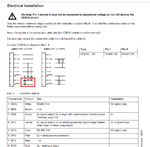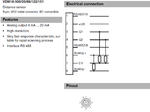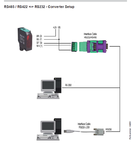Sandeep.Lerio
Junior Member level 1
Hello Everyone,
This is my first post on this forum., Seems like there are a lot of rules in this forum.
I have an analog output is 4-20mA industrial distance sensor. And I would like to interface the analog output of this sensor to a 5V microcontroller.
Normally a 250Ω resistor is used to get 1 to 5V measured across the resistor, but at this point, I'm not sure how this would connect to an Arduino because I don't know if analog- can be connected to Arduino GND.
I guess if I just connect the grounds together, and use something around 620Ω across analog+ and analog-. I'm getting about 10V swing (-5V to +5V) ... but the max resistance allowed in the specifications is <=500Ω.
Is there any way to connect analog output to 5v microcontroller? I attached the datasheet of the sensor, Please have a look let me know what you think about it
#sorry if this forum is not apporiate for this question.
This is my first post on this forum., Seems like there are a lot of rules in this forum.
I have an analog output is 4-20mA industrial distance sensor. And I would like to interface the analog output of this sensor to a 5V microcontroller.
Normally a 250Ω resistor is used to get 1 to 5V measured across the resistor, but at this point, I'm not sure how this would connect to an Arduino because I don't know if analog- can be connected to Arduino GND.
I guess if I just connect the grounds together, and use something around 620Ω across analog+ and analog-. I'm getting about 10V swing (-5V to +5V) ... but the max resistance allowed in the specifications is <=500Ω.
Is there any way to connect analog output to 5v microcontroller? I attached the datasheet of the sensor, Please have a look let me know what you think about it
#sorry if this forum is not apporiate for this question.



